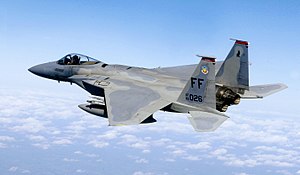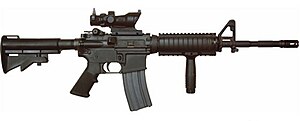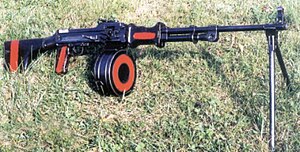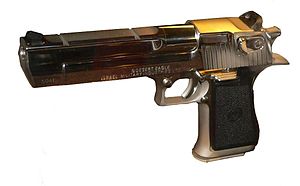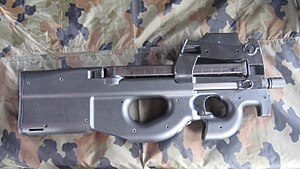M1918 Browning Automatic Rifle
| Rifle, Caliber .30, Automatic, Browning, M1918 |

The M1918A2 BAR |
| Type | Automatic rifle |
| Place of origin |  United States United States |
| Service history |
| In service | 1917–1960s (U.S.) |
| Used by | See Users |
| Wars | World War I, World War II, Chinese Civil War, Korean War, Vietnam War (limited), Palestinian Civil War |
| Production history |
| Designer | John Browning |
| Designed | 1917 |
| Manufacturer | Colt’s Patent Firearms Manufacturing Company, Winchester Repeating Arms Company, Marlin-Rockwell Corporation, Royal McBee Typewriter Company, Carl Gustafs Stads Gevärsfaktori, FN Herstal, Państwowa Fabryka Karabinów |
| Produced | 1917–1950s |
| Number built | 100,000+ (M1918) |
| Variants | See Variants |
| Specifications |
| Weight | 7.25 kg (15.98 lb) (M1918)
Approx. 11 kg (24 lb) (M1922)
8.4 kg (19 lb) (M1918A1)
8.8 kg (19 lb) (M1918A2)
9.0 kg (20 lb) (wz. 1928) |
| Length | 1,194 mm (47 in) (M1918, M1922, M1918A1)
1,215 mm (47.8 in) (M1918A2)
1,110 mm (43.7 in) (wz. 1928) |
| Barrel length | 610 mm (24.0 in) (M1918, M1922, M1918A1, M1918A2)
611 mm (24.1 in) (wz. 1928) |
|
| Cartridge | .30-06 Springfield (7.62x63mm) (M1918, M1922, M1918A1, M1918A2)
7.92x57mm Mauser (wz. 1928)
7.65x53mm Belgian Mauser (FN Mle 1930, FN Mle D)
7x57mm Mauser
6.5x55mm (Kg m/21, m/37)
.303 British (7.7x56mmR)
7.62x51mm NATO |
| Action | Gas-operated, tilting breech block |
| Rate of fire | 500–650 rounds/min (M1918, M1922, M1918A1)
300-450 or 500-650 rounds/min (M1918A2)
600 rounds/min (wz. 1928) |
| Muzzle velocity | 860 m/s (2,822 ft/s) (M1918, M1922, M1918A1, M1918A2)
853 m/s (2,798.6 ft/s) (wz. 1928) |
| Effective range | 100–1,500 yd sight adjustments |
| Maximum range | Approx. 4,500-5,000 yd |
| Feed system | 20-round detachable box magazine |
| Sights | Rear leaf, front post
784 mm (30.9 in) sight radius (M1918, M1922, M1918A1)
782 mm (30.8 in) (M1918A2)
742 mm (29.2 in) (wz. 1928) |
The BAR (short for Browning Automatic Rifle) is a family of American 7.62 mm automatic rifles (or machine rifles) and light machine guns used by the United States and numerous other countries during the 20th century. The primary variant of the BAR series is the M1918, chambered for the .30-06 Springfield (7.62x63mm) rifle cartridge and designed by John Browning in 1917 for the U.S. Expeditionary Corps in Europe as a replacement for (and improvement on) the French-made Chauchat and
Desert Eagle
Desert Eagle adalah pistol semi-otomatis kaliber besar yang diproduksi di Israel oleh Israel Military Industries (IMI), dibawah kontrak untuk Magnum Research, Inc.
Magnum Research, yang bermarkas di Amerika Serikat, mengembangkan dan mempatenkan desain awal Desert Eagle, yang kemudian dikembangkan lebih lanjut oleh IMI. Produksi dipindahkan ke Saco Defense di negara bagian Maine pada tahun 1995 sampai 2000, namun kemudian dipindahkan kembali ke Israel ketika Saco Defense dibeli oleh General Dynamics.
Dikarenakan reputasinya sebagai senjata yang berkekuatan tinggi, Desert Eagle sering ditampilkan sebagai senjata pilihan dalam berbagai novel, film, lagu, acara televisi, dan
FN F2000
The F2000 is an individual 5.56mm weapon system, developed at the turn of the 21st century by the Belgian armament manufacturer Fabrique Nationale (FN) of Herstal. The F2000 made its debut in March 2001 at the IDEX defense exhibition held in Abu
Mosin-Nagant
| Mosin-Nagant M91/30 |

|
| Type | Bolt-action rifle |
| Place of origin |  Russian Empire Russian Empire
 Soviet Union Soviet Union |
| Service history |
| In service | 1891-1998 |
| Used by | See Users |
| Wars | Russo-Japanese War, Russian Civil War, World War I, World War II, Korean War, Vietnam War, numerous others |
| Production history |
| Designer | Captain Sergei Mosin, Léon Nagant |
| Designed | 1891 |
| Manufacturer | Tula, Izhevsk, Sestroryetsk, Manufacture Nationale d'Armes de Châtellerault, Remington, New England Westinghouse, many others |
| Produced | 1891-1965 |
| Number built | approx 37,000,000 (Russia/Soviet Union) |
| Variants | see Variants |
| Specifications |
| Weight | 4 kg (8.8 lb) (M91/30)
3.4 kg (7.5 lb) (M38)
4.1 kg (9 lb) (M44) |
| Length | 1,232 mm (48.5 in) (M91/30)
1,013 mm (39.9 in) (carbines) |
| Barrel length | 730 mm (28.7 in) (M91/30)
514 mm (20.2 in) (carbines) |
|
| Cartridge | 7.62x54mmR |
| Action | Bolt-action |
| Muzzle velocity | Light ball, ~ 850 m/s (2,789 ft/s) rifle
~ 800 m/s (2,625 ft/s) carbine. |
| Feed system | 5-round non-detachable magazine, loaded singly or with five-round charger clips |
| Sights | Rear: ladder, graduated from 100m to 2000m (M91/30) and from 100m to 1000m (M38 and M44); Front: fixed post (drift adjustable) |
The Mosin-Nagant (Russian: Винтовка Мосина, ISO 9: Vintovka Mosina) is a bolt-action, internal magazine fed, military rifle that was used by the armed forces of the Russian Empire, the Soviet Union and various other nations, most of them from Eastern bloc. Also known as the Three-Line Rifle (Трёхлинейная винтовка, ISO 9: Trëhlinejnaâ vintovka), it was the first to use the 7.62x54mmR cartridge.
As a front-line rifle, the Mosin-Nagant served in various forms from 1891 until the 1960s in many Eastern European nations, when the sniper rifle variant was replaced by the SVD (Снайперская винтовка Драгунова, ISO 9: Snajperskaâ vintovka Dragunova). The Mosin-Nagant is still used in many conflicts due to its ruggedness
FN P90
The P90 is a Belgian designed submachine gun. The weapon’s name is an abbreviation of Project 90, which specifies a weapon system of the 1990s.[3] The P90 is considered a Personal Defense Weapon (PDW), and was designed as a compact but powerful firearm for vehicle drivers, operators of crew-served weapons, support personnel, special forces and anti-terrorist units.
Developed between 1986–1987 at Fabrique Nationale de Herstal, the P90 features a compact bullpup design, ambidextrous grip and a polymer and alloy-based construction. The weapon contains several innovative features including the proprietary 5.7x28mm ammunition, designed for greater penetration of body armour than pistol ammunition.
The P90 and variants are in use by military and police forces in over thirty countries worldwide, and sports models are popular among civilian shooters.
M249 squad automatic weapon
| Squad Automatic Weapon, 5.56 mm, M249 |

|
| Type | Squad automatic weapon/Light machine gun |
| Place of origin |  Belgium Belgium |
| Service history |
| In service | 1984–present |
| Used by |  United States Armed Forces United States Armed Forces |
| Wars | Invasion of Panama
Gulf War
Unified Task Force
Bosnian War
Kosovo War
Afghan War
Iraq War |
| Production history |
| Designed | 1976 |
| Manufacturer | Fabrique Nationale de Herstal |
| Unit cost | US$4,087[1] |
| Produced | late 1970s–present |
| Variants | See Variants |
| Specifications |
| Weight | 7.5 kg (17 lb) empty,
10 kg (22 lb) loaded |
| Length | 1,041 mm (41 in) |
| Barrel length | 521 mm (21 in) |
|
| Cartridge | 5.56x45mm NATO |
| Action | Gas-operated, open bolt |
| Rate of fire | 750–1,000 rounds/minute |
| Muzzle velocity | 915 m/s (3,002 ft/s) |
| Effective range | 1,000 m (1,094 yd) |
| Feed system | M27 linked belt, STANAG magazine |
The M249 squad automatic weapon (SAW), formally written as Squad Automatic Weapon, 5.56 mm, M249, is an American version of the FN Minimi, a light machine gun manufactured by the Belgian company Fabrique Nationale de Herstal (FN). The M249 is manufactured in the United States and is used by all branches of the U.S. Armed Forces. The gun was introduced in 1984 after being judged the most effective of a number of candidate weapons to address the lack of automatic firepower in small units. The gun provides the heavy volume of fire of a machine gun with accuracy approaching that of a rifle to infantry squads.
The M249 is gas-operated and air-cooled. It has a quick-change barrel, allowing the gunner to rapidly replace an overheated or jammed barrel. A folding bipod is attached near the front of the gun, though a heavy fixed tripod is also available to troops. It can be fed from both linked ammunition and STANAG magazines, like those used in the M16 and M4. This allows the SAW gunner to use rifleman's magazines as an emergency source of ammunition in the event that he runs out of linked rounds. However, this will often cause malfunctions because the magazine spring has difficulty feeding rounds quickly enough to match the SAW's high cyclic rate.
M249 SAWs have seen action in every major conflict involving the United States since the 1991 Gulf War. Soldiers are generally satisfied with the weapon's performance, though there have been many reports of clogging with dirt and sand. Due to the weight and age of the weapon, the U.S. Marine Corps (USMC) is considering designs for an infantry automatic rifle, which is planned to complement and partially replace the M249 in their service.
M1919 Browning machine gun
| Gun, Machine, Caliber .30, Browning, M1919A4 |

Browning M1919 |
| Type | Medium machine gun |
| Place of origin |  United States United States |
| Service history |
| In service | 1919–1970s (U.S.) |
| Used by | See Users |
| Wars | World War II, Korean War, Congo Crisis, Vietnam War, Bush War |
| Production history |
| Designed | 1919 |
| Produced | 1919–1945 |
| Variants | A1–A6; M37 |
| Specifications |
| Weight | 31 lb (14 kg) (M1919A4) |
| Length | - 37.94 in (964 mm) (M1919A4)
- 53 in (1346 mm) (M1919A6)
|
| Barrel length | 24 in (609 mm) |
|
| Cartridge | |
| Action | Recoil-operated/short-recoil operation |
| Rate of fire | 400–600 round/min |
| Muzzle velocity | 2,800 ft/s (853.6 m/s) |
| Effective range | 1,500 yd (1,370 m) (maximum) |
| Feed system | 250-round belt |
The Browning M1919 is a .30 caliber medium machine gun family widely used during the 20th century. It was used as a light infantry, coaxial, mounted, aircraft, and anti-aircraft machine gun by the U.S. and many other countries, especially during World War II, the Korean War, and the Vietnam War. Although it began to be superseded by newer designs in the later half of the century (such as by the M60 machine gun), it remained in use in many North Atlantic Treaty Organization (NATO) countries and elsewhere for much longer. It is very similar in design to the larger .50-caliber M2 Machine Gun, which is also a Browning-designed weapon and is still in NATO service.
Many M1919s were rechambered for the new 7.62 × 51 mm NATO round and served into the 1990s, as well as up to the present day in some countries. The United States Navy also converted many to 7.62 mm NATO, and designated them Mk 21 Mod 0; they were commonly used on river craft in the 1960s and 1970s in Vietnam.
M60 machine gun
The M60 (formally the United States Machine Gun, Caliber 7.62 mm, M60) is a family of American general purpose machine guns firing 7.62x51mm NATO cartridges from a disintegrating belt of M13 links. It can fire three types of ammunition, ball, tracer, and armor piercing.
Introduced in 1957, until recently it remained in use in every branch of the U.S military and still serves in other armed forces. Its manufacture and continued upgrade for military and commercial purchase continues into the 21st century though it has been replaced or supplemented in most roles by other designs, notably the M240 (U.S. Forces' nomenclature for the FN MAG-58) in U.S service.
IMI Galil
| Galil |
|---|

Galil 5,56 mm |
| Tipe | Senapan serbu |
| Negara asal |  Israel Israel |
| Sejarah pemakaian |
| Masa penggunaan | 1972–sekarang |
| Pada perang | Perang Lebanon 1982
Perang Irak |
| Sejarah produksi |
| Perancang | Yisrael Galili |
| Produsen | Israel Military Industries (IMI)
Bernadelli
Indumil
Ka Pa Sa State Factories |
| Spesifikasi |
| Berat | 3,75 kg (5,56 mm SAR)
3,95 kg (5,56 mm AR)
4,35 kg (5,56 mm ARM)
3,85 kg (7,62 mm SAR)
3,95 kg (7,62 mm AR)
4,45 kg (7,62 mm ARM)
6,40 kg (Sniper) |
| Panjang | 850 mm / 614 mm (popor dilipat)
(5,56 mm SAR)
987 mm / 742 mm (popor dilipat)
(5,56 mm AR, ARM)
915 mm / 675 mm (popor dilipat)
(7,62 mm SAR)
1050 mm / 810 mm (popor dilipat)
(7,62 mm AR, ARM)
1112 mm / 845 mm (popor dilipat)
(Sniper) |
| Panjang Laras | 332 mm (5,56 mm SAR)
460 mm (5,56 mm AR, ARM)
400 mm (7,62 mm SAR)
535 mm(7,62 mm AR, ARM)
508 mm (Sniper) |
|
| Magazen | 5,56 x 45 mm NATO
7,62 x 51 mm NATO |
| Mekanisme | Operasi gas, bolt berputar |
| Rata² tembakan | 630 to 750 rounds/min |
| Kecepatan peluru | 900 m/s (5,56 mm SAR)
950 m/s (5,56 mm AR, ARM)
800 m/s (7,62 mm SAR)
850 m/s (7,62 mm AR, ARM)
815 m/s
(Sniper) |
| Jarak efektif | 300 — 500 meter |
| Amunisi | Magazen 35 dan 50 butir (5,56 mm)
Magazen 25 butir (7,62 mm) |
| Alat bidik | Besi |
Galil adalah keluarga senjata ringan Israel yang dirancang oleh Yisrael Galili dan Yaacov Lior, yang diproduksi oleh Israel Military Industries (sekarang Israel Weapon Industries Ltd). Sistem senjata ini terdiri dari beberapa senapan kaliber 5,56 x 45 mm NATO dengan peluru M193 atau SS109 dan senapan 7,62 x 51 mm NATO.
Rancangan Galil dibuat berdasarkan rancangan RK 62 Finlandia, yang dibuat berdasarkan AK-47 Uni Soviet. Senapan ini memenangkan tender untuk Angkatan Pertahanan Israel dan mulai dipakai secara resmi pada tahun 1972. Galil tersedia dalam berbagai panjang laras, kapasitas magazen, dan peralatan pelengkap: karabin dengan nama SAR (Short Assault Rifle), versi kompak MAR (Micro Assault Rifle), panjang standar AR (Assault Rifle), dan senapan mesin ringan ARM (Assault Rifle and Machine gun).
Glock Pistol
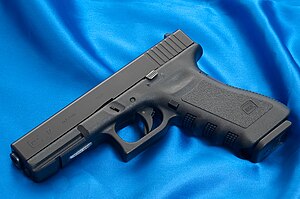
An early "third generation" Glock 17 Sebuah "awal generasi ketiga" Glock 17 |
| Type Jenis | Semi-automatic pistol Pistol semi-otomatis |
|---|
| Place of origin Tempat Asal | Austria Austria |
|---|
| Service history Layanan sejarah |
|---|
| In service Dalam pelayanan | 1982–present 1982-sekarang |
|---|
| Used by Digunakan oleh | See Users Lihat Pengguna |
|---|
| Production history Sejarah produksi |
|---|
| Designer Perancang | Gaston Glock Gaston Glock |
|---|
| Designed Dirancang | 1982 1982 |
|---|
| Manufacturer Pabrikan | Glock Ges.mbH Glock Ges.mbH |
|---|
| Produced Diproduksi | 1982–present 1982-sekarang |
|---|
| Number built Nomor dibangun | 2,500,000 [ 1 ] 2.500.000 [1] |
|---|
| Variants Varian | See Variants Lihat Varian |
|---|
| Specifications Spesifikasi |
|---|
| Cartridge Peluru | - 9x19mm Parabellum (Glock 17, 18, 19, 26, 34) 9x19mm Parabellum (Glock 17, 18, 19, 26, 34)
- 10mm Auto (Glock 20, 29) 10mm Auto (Glock 20, 29)
- .45 ACP (Glock 21, 30, 36) 0,45 ACP (Glock 21, 30, 36)
- .40 S&W (Glock 22, 23, 24, 27, 35) 0,40 S & W (Glock 22, 23, 24, 27, 35)
- .380 ACP (Glock 25, 28) 0,380 ACP (Glock 25, 28)
- .357 SIG (Glock 31, 32, 33) 0,357 SIG (Glock 31, 32, 33)
- .45 GAP (Glock 37, 38, 39) 0,45 GAP (Glock 37, 38, 39)
|
|---|
| Action Tindakan | Short recoil , locked breech, tilting barrel ( straight blowback for .380 ACP variants) takut pendek , sungsang terkunci, miring barel ( Blowback, operasi recoil lurus untuk 0,380 ACP varian) |
|---|
| Feed system Feed sistem | Box magazine , see Variants for capacities Kotak majalah , lihat Varian untuk kapasitas |
|---|
| Sights Pemandangan | Fixed, adjustable, and self-luminous night sights Tetap, diatur, dan bercahaya diri pemandangan malam |
|---|
The Glock is a series of semi-automatic pistols designed and produced by Glock Ges.mbH , located in Deutsch-Wagram , Austria . The Glock adalah serangkaian pistol semi-otomatis yang dirancang dan diproduksi oleh Glock Ges.mbH , berlokasi di Deutsch-Wagram , Austria . The company's founder, engineer Gaston Glock , had no experience with firearms design or manufacture at the time their first pistol, the Glock 17 , was being prototyped . Pendiri perusahaan, insinyur Gaston Glock , tidak punya pengalaman dengan desain atau pembuatan senjata api pada saat pistol pertama mereka, Glock 17, sedang prototyped . Glock did however have extensive experience in advanced synthetic polymers , knowledge which was instrumental in the company's design of the first successful line of pistols with a polymer frame. Namun Glock tidak memiliki pengalaman yang luas dalam sintetis maju polimer , pengetahuan yang sangat penting dalam perusahaan desain dari baris pertama yang berhasil pistol dengan bingkai polimer.
Despite initial resistance from the market to accept a 'plastic gun' due to concerns about their durability and reliability, Glock pistols have become the company's most profitable line of products, commanding 65% of the market share of handguns for United States law enforcement agencies [ 2 ] as well as supplying numerous national armed forces and security agencies worldwide. Meskipun resistensi awal dari pasar untuk menerima 'pistol plastik' karena kekhawatiran tentang ketahanan dan kehandalan, Glock pistol telah menjadi perusahaan yang paling menguntungkan baris produk, komandan 65% dari pangsa pasar senjata untuk Amerika Serikat aparat penegak hukum [ 2] serta menyediakan berbagai angkatan bersenjata nasional dan badan-badan keamanan di seluruh dunia.



